
In philately, a St. Andrew's cross is a saltire (an heraldic ordinary) or crossed x design that occurs on some philatelic items; on a few sheets of stamps, censor labels and a few British Forces air letter sheets issued during World War II.

In philately, a St. Andrew's cross is a saltire (an heraldic ordinary) or crossed x design that occurs on some philatelic items; on a few sheets of stamps, censor labels and a few British Forces air letter sheets issued during World War II.

The first St. Andrew's crosses are found on the first Austrian stamp issue from June 1, 1850 printed by the Vienna State Printing Works. They are colored crosses found in place of the last four stamp positions on each sheet as sold to the public. [2] [3] Leaving the last four labels free created a problem; the blank labels could be used by forgers to produce counterfeit stamps. For that reason, it was decided to make them unusable by printing the St. Andrew's cross design.
The crosses are the same color as their respective stamps and occur in two different types. They are either colored on a white background or the other way around. They are always found in the last row of the sheet and can either be placed in the center or on the left or the right edge.
At the time, the sheet of stamps as printed contained four panes, or counter sheets, each with eight rows and columns with 64 clichés per pane. [3] It was considered important that there not be an uneven payment when several sheets were purchased (for instance, by businesses). The extant Austria currency was the florin, each worth 60 kreutzers. For that reason, the idea of leaving the last four fields of a sheet free was considered. [3] For example, when buying seven 6-kreutzer sheets, the price was 42 florins instead of 44 florins and 48 kreutzers. With the introduction of the new currency in 1858 (100 kreutzers = 1 florin), the St. Andrew's cross was no longer needed and its use was discontinued. [3]

The St. Andrew's crosses were again used for a short time during the 1917 issue of special handling stamps that consisted of 13 rows and eight columns, so that 104 special handling stamps were on a pane. The middle four stamps in the bottom row were replaced by St. Andrew's crosses. The issue and printing of these sheets with St. Andrew's crosses was not originally planned but because of the public disapproval of the triangular predecessor, it was decided to change to horizontal format for this stamp issue.

St. Andrew's crosses are very popular with collectors today.[ citation needed ] However, few St. Andrew's crosses have survived from the first issue still attached to an adjacent stamp. They were hardly noticed at that time and nearly always torn away, or cut off. Some St. Andrew's cross labels were used to seal letters because they were gummed, so there are still several individual pieces or strips of four extant. Because philately was more widespread at that time many more St. Andrew's crosses exist from the 1916 issue.
In the Imperial postal censor station in Bermuda St. Andrew's crosses were usually applied in crayon, red, blue or black, to censor resealing labels or tapes used to seal mail being referred to a DAC, deputy assistant censor, or to another department for evaluation. Some of the crosses were applied after the censor labels had been stuck to the cover due to the cross only showing on the front of the label. [4] These, St. Andrew's cross censor labels are also recorded on Prize court mail that was detained in Bermuda and released or sold after the war, in late 1945 and 1946. [5]
An Imperial censor label, P.C.90, with the censor identity number 1000, occurs with the words "School use ONLY" at the top of a censor label that was used for training purposes. However, the location of use is unclear and could have been in the UK, Gibraltar or Bermuda. [6]

A postal stationery airmail letter sheet, entitled "Forces Letter Card", now commonly known as an aerogram, was made available during World War II for British military forces [7] and a few were issued with a large St. Andrew's cross printed on the front portion of the air letter. [8] [9]
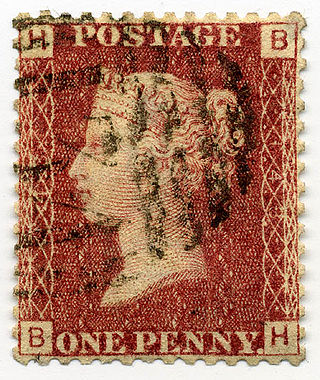
Philately is the study of postage stamps and postal history. It also refers to the collection and appreciation of stamps and other philatelic products. While closely associated with stamp collecting and the study of postage, it is possible to be a philatelist without owning any stamps. For instance, the stamps being studied may be very rare or reside only in museums.

A postage stamp is a small piece of paper issued by a post office, postal administration, or other authorized vendors to customers who pay postage. Then the stamp is affixed to the face or address-side of any item of mail—an envelope or other postal cover —which they wish to send. The item is then processed by the postal system, where a postmark or cancellation mark—in modern usage indicating date and point of origin of mailing—is applied to the stamp and its left and right sides to prevent its reuse. Next the item is delivered to its address.

For postage stamps, separation is the means by which individual stamps are made easily detachable from each other.
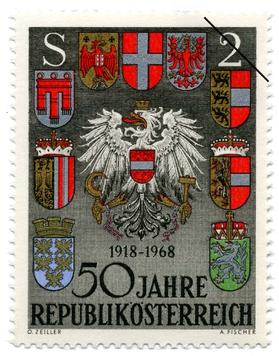
This article deals with the stamps and postal history of the Austrian Empire, Cisleithania within Austria-Hungary, and the Republic of Austria.

The Inverted Jenny is a 24 cent United States postage stamp first issued on May 10, 1918, in which the image of the Curtiss JN-4 airplane in the center of the design is printed upside-down; it is one of the most famous errors in American philately. Only one pane of 100 of the invert stamps was ever found, making this error one of the most prized in philately.

Postal history is the study of postal systems and how they operate and, or, the study of the use of postage stamps and covers and associated postal artifacts illustrating historical episodes in the development of postal systems. The term is attributed to Robson Lowe, a professional philatelist, stamp dealer and stamp auctioneer, who made the first organised study of the subject in the 1930s and described philatelists as "students of science", but postal historians as "students of humanity". More precisely, philatelists describe postal history as the study of rates, routes, markings, and means.
This is a list of philatelic topics.

Airmail is a mail transport service branded and sold on the basis of at least one leg of its journey being by air. Airmail items typically arrive more quickly than surface mail, and usually cost more to send. Airmail may be the only option for sending mail to some destinations, such as overseas, if the mail cannot wait the time it would take to arrive by ship, sometimes weeks. The Universal Postal Union adopted comprehensive rules for airmail at its 1929 Postal Union Congress in London. Since the official language of the Universal Postal Union is French, airmail items worldwide are often marked Par avion, literally: "by airplane".

An airmail stamp is a postage stamp intended to pay either an airmail fee that is charged in addition to the surface rate, or the full airmail rate, for an item of mail to be transported by air.

The postage stamps of Ireland are issued by the postal operator of the independent Irish state. Ireland was part of the United Kingdom of Great Britain and Ireland when the world's first postage stamps were issued in 1840. These stamps, and all subsequent British issues, were used throughout Ireland until the new Irish Government assumed power in 1922. Beginning on 17 February 1922, existing British stamps were overprinted with Irish text to provide some definitives until separate Irish issues became available within the new Irish Free State. Following the overprints, a regular series of definitive stamps was produced by the new Department of Posts and Telegraphs, using domestic designs. These definitives were issued on 6 December 1922, the day that the Irish Free State officially came into existence; the first was a 2d stamp, depicting a map of Ireland. Since then new images, and additional values as needed, have produced nine definitive series of different designs.

In philatelic terminology a letter sheet, often written lettersheet, is a sheet of paper that can be folded, usually sealed, and mailed without the use of an envelope, or it can also be a similar item of postal stationery issued by a postal authority. Letter sheets derive from the form in which written correspondence was made up before the mid-19th century—letters were written on one or more sheets of paper that were folded and sealed in such a way that the address could be written on the outside.

Definitive postage stamps of Ireland are the regular series of definitive postage stamps issued by the Irish Free State between 1922 and 1937 and by Republic of Ireland since 1937. Nine distinctly different series of designs have been released; additionally the watermark was changed for two issues and the currency was changed on three occasions while the designs remained the same.
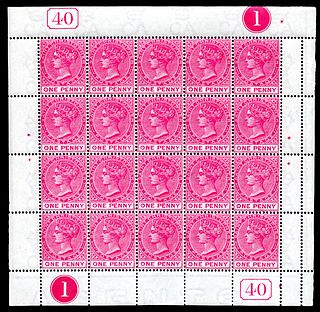
A sheet of stamps or press sheet is a unit of stamps as printed, usually on large sheets of paper based on the size of the printing plate, that are separated into panes that are sold at post offices. Where more than one pane is on a printed sheet they are arranged in a table-like arrangement. The spaces between the single stamps are all of the same size and provide space for a cut or perforation.
Between 1851 and 1860, the Grand Duchy of Tuscany, an independent Italian state until 1859 when it joined the United Provinces of Central Italy, produced two postage stamp issues which are among the most prized classic stamp issues of the world, and include the most valuable Italian stamp.
The Stamp Specialist is the title of a series of books on philatelic research written and edited for the advanced collector of postage stamps.

In philately, a cut-out is an imprinted stamp cut from an item of postal stationery such as a postal card, letter sheet, aerogramme or wrapper that may have been used as a normal stamp.
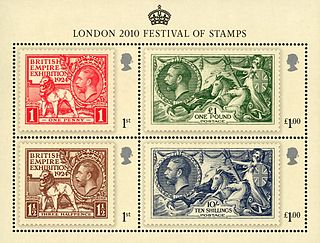
The London 2010 International Stamp Exhibition, 8–15 May 2010 at the Business Design Centre in Islington, London, was a major international stamp exhibition that was granted FIP patronage.
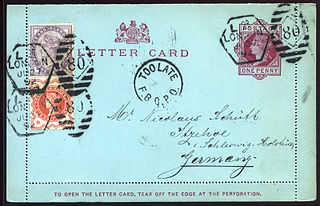
In philately, a lettercard or letter card is a postal stationery item consisting of a folded card with a prepaid imprinted stamp. That it is folded over gives the writer twice as much room for the message compared with a postal card. The message is written on the inside and the card is then folded and sealed around the edges. The recipient tears off and discards the perforated selvages to open the card.

The first postage stamps of Bhutan were issued in 1962, the same year that the first motorable road was opened. Before that there was a mail delivery system in place for official mail using mail runners, and between 1955 and 1962 revenue stamps were accepted as payment for internal mail. With the opening up of Bhutan in the early 1960s, a formal postal system was introduced.

The 1930 Graf Zeppelin stamps were a set of three airmail postage stamps, each depicting the image of the Graf Zeppelin, issued by the United States Post Office Department in 1930, exclusively for delivery of mail carried aboard that airship. Although the stamps were valid for postage on mail sent on the Zeppelin Pan American flight from Germany to the United States, via Brazil, the set was marketed to collectors and was largely intended to promote the route. 93.5% of the revenue generated by the sale of these stamps went to the Zeppelin Airship Works in Germany. The Graf Zeppelin stamps were issued as a gesture of goodwill toward Germany. The three stamps were used briefly and then withdrawn from sale. The remainder of the stock was destroyed by the Post Office Department. Due to the high cost of the stamps during the Great Depression, most collectors and the general public could not afford them. Consequently, only about 227,000 of the stamps were sold, just 7% of the total printed, making them relatively scarce and prized by collectors.